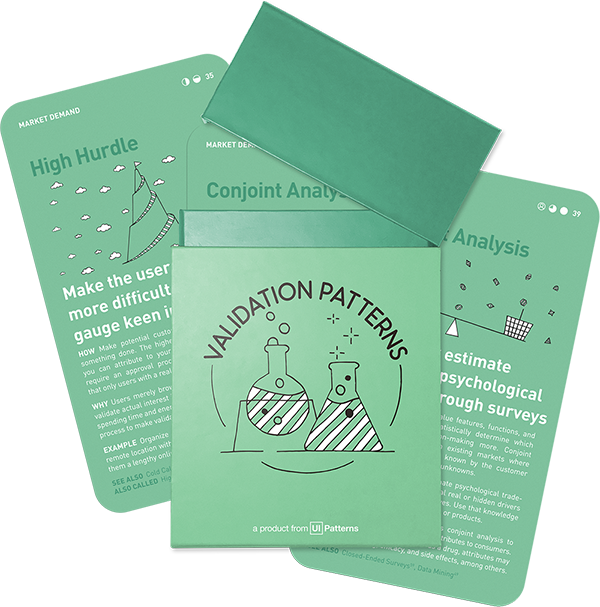Idea Validation: Problem
Find the Watering Hole
Seek out where prospects gather for informal face-to-face validation

How: Go where your potential customers gather for pleasure or work to validate critical assumptions in an informal setting. Typical places are conferences, trade shows, seminars, bars, hotels, meetup groups, or other networking events.
Why: Finding the watering hole provides a direct channel to potential customers. People are eager to talk about the things they care deeply about and the problems they are trying to solve. Keep your conversations about the customer – about their world.
The Find the Watering Hole experiment involves identifying and engaging with potential customers in their natural settings or platforms where they already congregate.
In practice, companies might observe online forums, industry groups, LinkedIn discussions, or specialized trade shows to understand where their potential customers are most active. By participating in these spaces, companies can gather insights about customer needs, industry trends, and pain points. This approach helps in refining product offerings, tailoring marketing strategies, and developing more targeted sales pitches that resonate with the target audience.
For a B2B company, this method is not only cost-effective but also allows for a deeper understanding of the market, which is crucial for long-term success. While specific examples are not readily available, this approach is commonly used across various industries for market research and validation.
In the context of B2B, this strategy is often used to gain insights into the needs and pain points of potential customers, build relationships, and test market hypotheses. For example, a company developing a new software tool for project management might engage with professional groups on LinkedIn or specialized forums where project managers discuss their challenges. By participating in these discussions and gathering feedback, the company can validate the demand for their product, refine its features, and build a customer base even before the official launch.
This method is particularly effective in the B2B sector due to the longer sales cycles and the importance of relationship-building in business transactions. By engaging directly with potential customers in their preferred environments, companies can establish trust and credibility, which are crucial for successful B2B sales.
Search for questions to find the watering holes
Google and other search engines are great sources for finding watering holes. A great hack for this is to imagine what questions your customers are asking and typing that into the search console. This technique can both help you reveal where your target audience spends time, what kind of people they are, but also how they are solving the problem today.
Good opening phrases for questions focus on how existing problems are solved. Examples could be:
- “How to…”
- “Best ways to…”
- “Tutorial for…”
Examine the competition
Chances are that existing players in the market have already found part of the watering hole and have attracted users from it. A great tool for analyzing competitor audiences is SEO link tools, which lists all inbound links to a competitor’s site. These will not only show where your audience might gather, but also hint as to how your can mention your product in an non-intrusive way.
Classic examples
An example of a company successfully employing the “Find the Watering Hole” experiment is Spotfire, a Swedish data visualization startup. Spotfire effectively leveraged this strategy when expanding into the American market. Specifically, they targeted the energy sector and made a strategic decision to open a new sales office in the same building as lunch restaurants frequented by executives from major oil companies like BP and Shell. This proximity facilitated serendipitous interactions with important oil company executives, which proved instrumental in validating their market and securing deals in the energy sector. This approach ultimately contributed to their significant success, leading to a $195 million acquisition by Tibco Software.
This case demonstrates the effectiveness of the “Find the Watering Hole” strategy in gaining access to potential customers and validating market interest in a real-world setting. Spotfire’s method focused on understanding and integrating into the environment where their prospective clients congregated, thereby enhancing their ability to connect with key decision-makers and validate their product in the target market.
Well suitedd for B2B companies
For B2B companies, engaging directly with potential customers in their preferred environments, like professional groups or industry forums, is especially effective due to the longer sales cycles and the importance of relationship-building in business transactions.
This strategy is commonly used for market research and validation, allowing companies to establish trust and credibility with potential customers, which are crucial for successful B2B sales.
Popular tools
The tools below will help you with the Find the Watering Hole play.
-
Moz Link Explorer
Link building tool that provide link analysis and competitive research.
-
Ahrefs
SEO research tool to research your competitors and monitor your niche.
Real life Find the Watering Hole examples
Spotfire
When Swedish data visualization startup Spotfire started targeting the American energy sector, it opened a new sales office in the same building as the lunch restaurants of energy giants like BP and Shell to serendipitously gain access to important oil company executives.
Source: The Importance of Watering Holes in Product-Market Validation
Flutura
The founders of the AI energy app made it a habit to go meet potetial customers where which wouldn’t have been expressed in a formal controlled setting. It helped them be problem-backward and not technology-forward.
Source: How Flutura Built A Painkiller Product By Fully Immersing In The Energy Industry
A collection of 60 product experiments that will validate your idea in a matter of days, not months. They are regularly used by product builders at companies like Google, Facebook, Dropbox, and Amazon.
Get your deck!Related plays
- Thirsty For New Customers? by Brad and Debra Schepp
- Quench Your Thirst For Customers by Brad and Debra Schepp
- Create Products Businesses Want by Brad and Debra Schepp

